 W
WThe Age of Reason is a 1945 novel by the philosopher Jean-Paul Sartre. It is the first part of the trilogy The Roads to Freedom. The novel, set in the bohemian Paris of the late 1930s, focuses on three days in the life of philosophy teacher Mathieu who is seeking money to pay for an abortion for his mistress, Marcelle. Sartre analyses the motives of various characters and their actions and takes into account the perceptions of others to give the reader a comprehensive picture of the main character.
 W
WDeath Sentence is a philosophical novel by Maurice Blanchot. First published in 1948, it is his second complete work of fiction.
 W
WThe Blood of Others is a novel by the French existentialist Simone de Beauvoir first published in 1945 and depicting the lives of several characters in Paris leading up to and during the Second World War. The novel explores themes of freedom and responsibility.
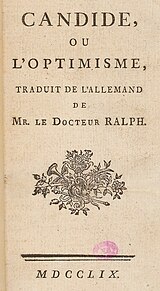 W
WCandide, ou l'Optimisme is a French satire first published in 1759 by Voltaire, a philosopher of the Age of Enlightenment. The novella has been widely translated, with English versions titled Candide: or, All for the Best (1759); Candide: or, The Optimist (1762); and Candide: Optimism (1947). It begins with a young man, Candide, who is living a sheltered life in an Edenic paradise and being indoctrinated with Leibnizian optimism by his mentor, Professor Pangloss. The work describes the abrupt cessation of this lifestyle, followed by Candide's slow and painful disillusionment as he witnesses and experiences great hardships in the world. Voltaire concludes Candide with, if not rejecting Leibnizian optimism outright, advocating a deeply practical precept, "we must cultivate our garden", in lieu of the Leibnizian mantra of Pangloss, "all is for the best" in the "best of all possible worlds".
 W
WThe Lesbian Body is a 1973 novel by Monique Wittig. It was translated into English in 1975.
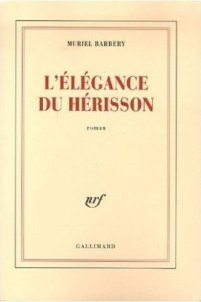 W
WThe Elegance of the Hedgehog is a novel by the French novelist and philosophy teacher Muriel Barbery. The book follows events in the life of a concierge, Renée Michel, whose deliberately concealed intelligence is uncovered by an unstable but intellectually precocious girl named Paloma Josse. Paloma is the daughter of an upper-class family living in the upscale Parisian apartment building where Renée works.
 W
WExploits and Opinions of Dr. Faustroll, Pataphysician. A novel by French Symbolist author Alfred Jarry which influenced Surrealism, it features Doctor Faustroll, a scientist who is born in 1898 in Circassia at the age of 63, and who dies the same year at the same age.
 W
WThe Fall is a philosophical novel by Albert Camus. First published in 1956, it is his last complete work of fiction. Set in Amsterdam, The Fall consists of a series of dramatic monologues by the self-proclaimed "judge-penitent" Jean-Baptiste Clamence, as he reflects upon his life to a stranger. In what amounts to a confession, Clamence tells of his success as a wealthy Parisian defense lawyer who was highly respected by his colleagues. His crisis, and his ultimate "fall" from grace, was meant to invoke, in secular terms, the fall of man from the Garden of Eden. The Fall explores themes of innocence, imprisonment, non-existence, and truth. In a eulogy to Albert Camus, existentialist philosopher Jean-Paul Sartre described the novel as "perhaps the most beautiful and the least understood" of Camus' books.
 W
WGerminal is the thirteenth novel in Émile Zola's twenty-volume series Les Rougon-Macquart. Often considered Zola's masterpiece and one of the most significant novels in the French tradition, the novel – an uncompromisingly harsh and realistic story of a coalminers' strike in northern France in the 1860s – has been published and translated in over one hundred countries and has additionally inspired five film adaptations and two television productions.
 W
WIn Search of Lost Time, also translated as Remembrance of Things Past, is a novel in seven volumes by Marcel Proust (1871–1922). It is his most prominent work, known both for its length and its theme of involuntary memory; the most famous example of this is the "episode of the madeleine," which occurs early in the first volume. It gained fame in English in translations by C. K. Scott Moncrieff and Terence Kilmartin as Remembrance of Things Past, but the title In Search of Lost Time, a literal rendering of the French, became ascendant after D. J. Enright adopted it for his revised translation published in 1992.
 W
WJacques the Fatalist and his Master is a novel by Denis Diderot, written during the period 1765–1780. The first French edition was published posthumously in 1796, but it was known earlier in Germany, thanks to Schiller's partial translation, which appeared in 1785 and was retranslated into French in 1793, as well as Mylius's complete German version of 1792.
 W
WJulie; or, The New Heloise, originally entitled Lettres de Deux Amans, Habitans d'une petite Ville au pied des Alpes, is an epistolary novel by Jean-Jacques Rousseau, published in 1761 by Marc-Michel Rey in Amsterdam.
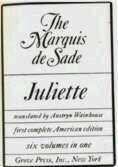 W
WJuliette is a novel written by the Marquis de Sade and published 1797–1801, accompanying Sade's 1797 version of his novel Justine. While Justine, Juliette's sister, was a virtuous woman who consequently encountered nothing but despair and abuse, Juliette is an amoral nymphomaniac murderer who is successful and happy. The full title of the novel in the original French is L'Histoire de Juliette ou les Prospérités du vice, and the English title is "Juliette, or Vice Amply Rewarded". As many other of his works, Juliette follows a pattern of violently pornographic scenes followed by long treatises on a broad range of philosophical topics, including theology, morality, aesthetics, naturalism and also Sade's dark, fatalistic view of world metaphysics.
 W
WThe Little Prince is a novella by French aristocrat, writer, and aviator Antoine de Saint-Exupéry. It was first published in English and French in the US by Reynal & Hitchcock in April 1943, and posthumously in France following the liberation of France as Saint-Exupéry's works had been banned by the Vichy Regime. The story follows a young prince who visits various planets in space, including Earth, and addresses themes of loneliness, friendship, love, and loss. Despite its style as a children's book, The Little Prince makes observations about life and human nature.
 W
WMan's Fate is a 1933 novel written by André Malraux. It was translated into English twice, both translations appearing in 1934, one by Haakon Chevalier under the title Man's Fate, published by Harrison Smith & Robert Haas in New York and republished by Random House as part of their Modern Library from 1936 on, and the other by Alastair MacDonald under the title Storm in Shanghai, published by Methuen in London and republished, still by Methuen, in 1948 as Man's Estate, to become a Penguin pocket in 1961. Currently the Chevalier translation is the only one still in regular print. The novel is about the failed communist insurrection in Shanghai in 1927, and the existential quandaries facing a diverse group of people associated with the revolution. Along with Les Conquérants and La Voie Royale, it forms a trilogy on revolution in Asia.
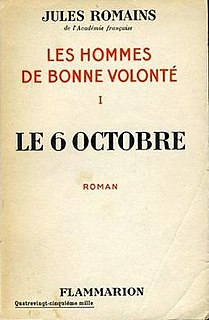 W
WLes Hommes de bonne volonté is an epic roman-fleuve by French writer Jules Romains, published in 27 volumes between 1932 and 1946. It has been classified both as a novel cycle and a novel and, at two million words and 7,892 pages, has been cited as one of the longest novels ever written.
 W
WMystification or l'Histoire des portraits is an unfinished work from 1768 by Denis Diderot. It was published in 1951. A second edition in 1954 by Pierre Daix, annotated by Yves Benot was illustrated with four sketches by Pablo Picasso, for Les Éditeurs français réunis. A film based on the work was directed by fr:Sandrine Rinaldi in 2005.
 W
WNausea is a philosophical novel by the existentialist philosopher Jean-Paul Sartre, published in 1938. It is Sartre's first novel and, in his own opinion, one of his best works.
 W
WLa Peau de chagrin, known in English as The Wild Ass' s Skin is an 1831 novel by French novelist and playwright Honoré de Balzac (1799–1850). Set in early 19th-century Paris, it tells the story of a young man who finds a magic piece of shagreen that fulfills his every desire. For each wish granted, however, the skin shrinks and consumes a portion of his physical energy. La Peau de chagrin belongs to the Études philosophiques group of Balzac's sequence of novels, La Comédie humaine.
 W
WPersian Letters is a literary work, published in 1721, by Charles de Secondat, baron de Montesquieu, recounting the experiences of two fictional Persian noblemen, Usbek and Rica, who are traveling through France.
 W
WRameau's Nephew, or the Second Satire is an imaginary philosophical conversation by Denis Diderot, written predominantly in 1761–62 and revised in 1773–74.
 W
WThe Reprieve is a 1945 novel by Jean-Paul Sartre.
 W
WL'Étranger is a 1942 novel by French author Albert Camus. Its theme and outlook are often cited as examples of Camus's philosophy, absurdism coupled with existentialism, though Camus personally rejected the latter label.
 W
WThérèse Philosophe is a 1748 French novel ascribed to Jean-Baptiste de Boyer, Marquis d'Argens. It has been chiefly regarded as a pornographic novel, which accounts for its massive sales in 18th-century France. Aside from that however, this novel represents a public conveyance for some ideas of the Philosophes.
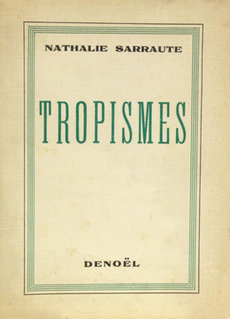 W
WTropisms is an experimental novel by Nathalie Sarraute, first published in 1939. It is considered a forerunner of the Nouveau Roman. Jean Genet, Marguerite Duras and Jean-Paul Sartre all described it as a masterpiece.
 W
WTroubled Sleep is a 1949 novel by Jean-Paul Sartre. The book was originally translated as Iron in the Soul. It is the third part in the trilogy Les chemins de la liberté.
 W
WZadig; or, The Book of Fate is a novella and work of philosophical fiction by the Enlightenment writer Voltaire. It tells the story of Zadig, a philosopher in ancient Babylonia. The author does not attempt any historical accuracy, and some of the problems Zadig faces are thinly disguised references to social and political problems of Voltaire's own day.